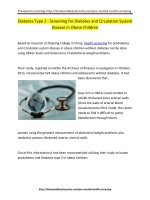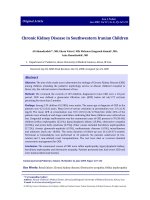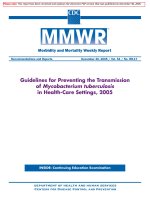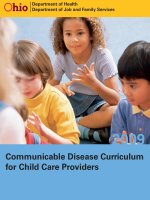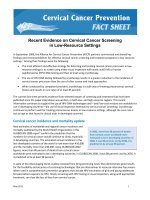Recognizing and Preventing Infectious Disease in Child Care Settings ppt
Bạn đang xem bản rút gọn của tài liệu. Xem và tải ngay bản đầy đủ của tài liệu tại đây (125.37 KB, 16 trang )
Beyond the Fundamentals: HEALTHY AND SAFE ENVIRONMENTS
Recognizing and Preventing Infectious Disease
in Child Care Settings
(3 hours)
Peggy Poppe - April 2011
Table of contents for this document
A.
Instructor Qualifications
B.
Northern Lights Early Childhood Competencies related to this module
C.
Module outline
D.
Sample Agenda
E.
Sample Activities
F.
Background Information for Instructors
A. Instructor Qualifications: Health Care Professionals with Knowledge of
National Child Care Health and Safety Standards as outlined in Caring for Our
Children Vermont Child Care
Licensing regulations and regulations and knowledge of the context of working with
children and families from birth through school age in group care.
Note to the instructor:
This is an outline of consistent, yet flexible curriculum to use to teach early
childhood professionals across Vermont about the specific Northern Lights Core
Competencies for Early Childhood Professionals listed in the “Outline of content and
Northern Lights Core Competencies for Early Childhood Professionals”.
The materials here are not intended to be a “canned” curriculum, but rather a guide
to use as you plan for instructing on these concepts. This curriculum outline and
agenda correspond with the core competencies. The outline of topics must be
addressed; however, the teaching methodology and format of delivery are flexible.
Links to model lesson plans as well as sample activities are provided as resources.
Background information about the topic is provided as a reference for talking points.
Information changes periodically. The instructor is expected to check current
resources to assure that information is current and up to date. For further
information, please contact the Vermont Northern Lights Career Development
Center ( ).
B. Northern Lights Core Competencies for Early Childhood Professionals: The
following list of competencies relates to this training.
Professionalism And Program Organization
• Identifies local, state, and national organizations that advocate for children,
families, and early childhood professionals
Families And Communities : Community Involvement and Resources
Beyond the Fundamentals: Healthy and Safe Environments – Recognizing & Preventing Infectious
Diseases
pg 2 of 16
• Demonstrates knowledge of community resources that support children and
families
Healthy And Safe Environments : Healthy Environments and Health Needs
• Demonstrates and provides instruction for new staff and volunteers on hand
washing, diapering, toileting, and sanitation practices
• Demonstrates and provides instruction for new staff and volunteers on hand
washing, diapering, toileting, and sanitation practices.
• Develops and implements policies regarding exclusion and readmission of sick
children
• Follows up with parents about maintaining accurate immunization records
C. Module Overview
Recognizing and Preventing Infectious Diseases in Child Care Settings:
Time
Objectives
Training
Techniques
Equipment
Topics/ Content
3 hours
This training is designed so that participants will acquire the
knowledge and skills needed for them to:
• Describe factors that impact the spread of infections: type of
infection, route of transmission, and personal risks.
• Identify practices that prevent the spread of infectious
disease in childcare programs.
• Review and adapt an infection control policy for a child-care
program which is in compliance with Vermont Licensing rules
and regulations
Lecture, small group work, video, repeat demonstration
DVD, sink, LCD projector and lap top computer
Infections in Child Care Settings
• Factors causing increased exposure
• Types of infections
• Routes of infection
• Risks to children and staff
Prevention strategies
• Daily Health Check
• Exclusion practices
• Immunizations children and staff
• Hand washing
• Sanitizing surfaces
• Diapering procedure/toileting
• Reportable diseases to VDH and informing parents
• Blood Borne Pathogens requirement
• Infection Control Policies
• Considerations for staff of child bearing age
• Vermont Licensing
Beyond the Fundamentals: Healthy and Safe Environments – Recognizing & Preventing Infectious
Diseases
pg 3 of 16
Key References
Model Lesson
Plans
Model Lesson
Plans (cont.)
Caring for Our Children
/>Early Childhood Program Licensing Regulations State of
Vermont />hood_Program.pdf (section V G)
Health and Safety in the Child Care Setting: Prevention of Infectious
Diseases. />.pdf
Managing Infectious Diseases in Early Education and Child Care
Settings, 2010
/>Preventing and Managing Illness in ECE Programs
/>nessPrev_0506.pdf
Sample Activities
Symptoms of Illness Activity
Hand washing Activity
Infectious Disease Policy Activity
Handouts for
Participants
Handout B
Handout C
Hand washing Checklist
California Child Care Health Program Survival Tips Posters
/>California Child Health Program Fact Sheets for Families
/>Introduction to Infectious Diseases Unit 1: Instructional Activities for
ages 2-6 />
Handouts for
Families
Classroom Ideas
for Teachers
Book: Germs are not for Sharing by Elizabeth Verdick
Beyond the Fundamentals: Healthy and Safe Environments – Recognizing & Preventing Infectious
Diseases
pg 4 of 16
D. Sample Agenda (3 hours)
Beyond the Fundamentals: Healthy and Safe EnvironmentsRecognizing and Preventing Infectious Diseases
Time
Content
10min
Welcome /Introductions
10min
20min
Ice Breaker
Overview of Communicable
Diseases in Child Care (why are
staff and children at risk? Routes
of infection)
Types of Infections
Staff risks
Exclusion guidelines
20 min
Method
20
15
30
Prevention strategies:
Daily Health Check
Exclusion
Immunizations children and staff
Reportable diseases to VDH and
Informing parents
Sanitizing
Break
Lecture/Power Point
Symptoms of Illness Activity
Lecture /discussion
Power Point
AAP video segments
Review handouts
Hand washing Activity and checklist
Hand washing
15
10
20
Classroom ideas
Diapering Demonstration
Blood Borne Pathogens Standard
Policies in Child Care
Settings/why/components
Required policies
(licensing/standards)
10
Demonstration: Ask someone to review
steps in Licensing regulations and
demonstrate using a doll (highlight frequently
missed steps)
AAP slide diapering area /discussion
Power Point
Lecture
Lecture
Hand washing Policy Activity
Discussion
Implementing and communicating
policies to parents
Wrap up
E. Sample Activities
Symptoms of Illness Activity
Beyond the Fundamentals: Healthy and Safe Environments – Recognizing & Preventing Infectious
Diseases
pg 5 of 16
-
Facilitator Instructions -
Instructions: Participants can work individually or in pairs. Ask each group of two or
three choose one of the following illnesses. Assure that all illnesses are covered.
•
•
•
•
•
•
•
Rotavirus (pg. 127)
Parvovirus/Fifths Disease (pg. 75-76)
CMV (pg. 63)
Chickenpox/Varicella (pg. 61-62)
Impetigo (pg. 91)
MRSA (pg.111)
Any other of special interest
Ask each small group to review the illnesses in the materials provided and
summarize the following points for the group.
(Use the Managing Infectious Diseases in Child Care and Schools or provide other
reference material such California Child Care Health Program Illness Sheets
/>What are the major signs and symptoms?
• How long does it take to incubate (time between exposure and illness)
•
How long is it contagious?
•
How is it spread?
•
How is it controlled?
•
Special roles of Caregivers/teachers?
•
Should a child with this illness be excluded from care? Under what
conditions? (Check Vermont Licensing Regulations)
Ask someone form each group to share key points with the larger ITV group.
Beyond the Fundamentals: Healthy and Safe Environments – Recognizing & Preventing Infectious
Diseases
pg 6 of 16
Sample Activity
Symptoms of Illness Activity
Participant Handout
Instructions: Work individually or in pairs. Choose one of the following illnesses.
•
•
•
•
•
•
•
Rotavirus (pg. 127)
Parvovirus/Fifths Disease (pg. 75-76)
CMV (pg. 63)
Chickenpox/Varicella (pg. 61-62)
Impetigo (pg. 91)
MRSA (pg.111)
Any other of special interest
Use the references provided to answer the following questions and summarize the
key points. Be prepared to share your findings with the larger group.
•
Describe the illness briefly? (Is it a virus, bacteria or other and other key
facts)?
•
What are the major signs and symptoms?
•
How long does it take to incubate (time between exposure and illness)
•
How long is it contagious?
•
How is it spread?
•
How is it controlled?
•
Special roles of Caregivers/teachers?
•
Should a child with this illness be excluded from care? Under what
conditions? (Check Vermont Licensing Regulations)
Beyond the Fundamentals: Healthy and Safe Environments – Recognizing & Preventing Infectious
Diseases
pg 7 of 16
Sample Activity
Hand Washing Activity
Materials: Sink with soap and paper towels. Cornstarch, glitter, cinnamon, and
hand lotion, and check list.
Instructions:
Ask for one person to volunteer to spread cornstarch “germs” by apply a liberal
amount of cornstarch to their hands and then asking all participants to shake hands
with everyone in the group. shaking hands with everyone in the group.
Lead a brief discussion of how the germs spread. Then ask participants to practice
good hand washing.
Ask participants to find a partner. Ask each person to choose either glitter or
cinnamon to wash off his or her hands. (Applying hand lotion before applying either
glitter or cinnamon works best.)
Ask partners to practice hand washing according to the checklist. Partners will
instruct each other using the checklist as a guide.
Remind participants that good hand washing is essential for both children and staff.
They can use the cornstarch and glitter to teach this skill to children in their care.
Using the glitter or cinnamon will provide an opportunity for them to try out the
materials.
Classroom Curriculum:
Introduction to Infectious Diseases Unit 1: Instructional Activities for ages 2-6
/>Book: Germs are not for Sharing by Elizabeth Verdick
Beyond the Fundamentals: Healthy and Safe Environments – Recognizing & Preventing Infectious
Diseases
pg 8 of 16
Hand Washing Checklist
Check to see that paper towel or single
use personal towel is available
Turn on warm water 60-120 degrees
Moisten hands and apply liquid soap
Rub hands together at least 10 seconds
rubbing areas between fingers, around
nail beds, fingernails, jewelry and back
of hands (sing hand washing song)
Rinse hands leaving water running
while drying hands
Dry hands with disposable or single
use towel
Turn off tap with towel if not
automatic
Use hand lotion
Beyond the Fundamentals: Healthy and Safe Environments – Recognizing & Preventing Infectious
Diseases
pg 9 of 16
ACTIVITY: REVIEWING A CHILD CARE HEALTH AND SAFETY POLICY
Instructions: Read/review the policy. Does the policy address the eleven criteria
for what a health policy should include. The policy should meet the minimum
licensing requirements but can exceed them based upon current research and
guidelines. Provide licensing regulations and copies of related Standards from
Caring for Our Children.
1. Title
2. Belief Statement
3. Intent Statement
4. Background
5. Procedure/Practice
6. Application
7. Communication
8. References
9. Review
10. Effective Date
11. Review Date
Adapted from: Cimino J and The National Training Institute for Child Care Health
Consultants. Building consultation skills: policy development trainer’s guide: version 1.
Chapel Hill (NC): The National Training Institute for Child Care Health Consultants,
Department of Maternal and Child Health, The University of North Carolina at Chapel Hill;
2007.
_______________________________________________________________
Beyond the Fundamentals: Healthy and Safe Environments – Recognizing & Preventing Infectious
Diseases
pg 10 of 16
HAND WASHING POLICY
ABC Child Care Center believes that proper hand washing is the most effective way
to decrease the spread of communicable disease.
Frequent hand washing by childcare providers and children is the most effective
way to prevent spreading germs (CDC, 2004).
This policy is intended to keep children, families, and staff healthier.
This policy was developed in response to an increase in a communicable disease.
(This is background information that a particular center wanted to include because
there had been a Salmonella outbreak. Not every policy will have a background
statement.)
ABC Child Care Center requires all providers (staff/volunteer) to wash their hands at
the following times:
o Upon arrival at work
o Before preparing or handling food, or feeding children
o After using the toilet, assisting children with toileting, or changing diapers
o After contact with any bodily fluids or secretions
o After handling pets or caring for pets
o Before administering any type of medication, or applying ointments/creams
o After cleaning surfaces or toys
o Whenever hands are visibly dirty
o Before leaving work
All children attending the program are required to wash their hands:
o Upon arrival
o Before and after eating
o After using the toilet or having diapers changed
o After playing outside
o After handling or feeding animals/pets, or handling animal cages
o When hands are visibly dirty
o Before leaving the center
Beyond the Fundamentals: Healthy and Safe Environments – Recognizing & Preventing Infectious
Diseases
pg 11 of 16
This policy applies to staff employed by the program, all volunteers, parents, and all
children attending the program. Staff and volunteers will receive a written copy of
this policy in their orientation packets before their first day at the center. All parents
will receive a written copy of this policy in the parent handbook. A copy of this
policy will be posted on the parent bulletin board in each classroom. Parents will
receive written notification of any necessary updates.
References
Centers for Disease Control and Prevention. An ounce of prevention: Keeps the
germs away. [online] 2004 Available from: URL:
/>
Adapted from: Cimino J and The National Training Institute for Child Care Health
Consultants. Building consultation skills: policy development trainer’s guide: version 1.
Chapel Hill (NC): The National Training Institute for Child Care Health Consultants,
Department of Maternal and Child Health, The University of North Carolina at Chapel Hill;
2007.
_______________________________________________________________
Beyond the Fundamentals: Healthy and Safe Environments – Recognizing & Preventing Infectious
Diseases
pg 12 of 16
Sample Activity
Bingo/Jeopardy:
Test participants’ comprehension and knowledge by playing Bingo, Jeopardy, or
another game. To play Bingo, create a grid of 4X4 squares. Write a couple of
different combinations of the names of infections on the squares, copy them, and
distribute a game card and some little scraps of paper, paper clips,
pennies, or other game pieces to each person. After your presentation, wrap
up by asking questions which participants answer by playing Bingo. The
winner(s) could assist you with another activity in the session.
Beyond the Fundamentals: Healthy and Safe Environments – Recognizing & Preventing Infectious
Diseases
pg 13 of 16
F. Background Information for Instructors to Use in Preparing Presentations:
Materials adapted and used with permission from: National Training Institute for
Child Care Health Consultants Staff. Caring for the health and safety of child care
staff. Chapel Hill, NC: National Training Institute for Child Care Health Consultants,
Department of Maternal and Child Health, The University of North Carolina at
Chapel Hill; 2003.
Factors That Increase the Spread of Infection in Child Care Settings:
Childcare brings children together in close contact for routine care, play, and
learning. Some characteristics unique to group childcare also increase the risk of
transmission of infectious disease to the staff.
Child care staff acquire infectious diseases at a higher rate than adults who
have less contact with children because of their exposure to the diseases
that the young children they work with have.
Children are at risk because infants have immature immune systems that
make them especially vulnerable to infections that they can then transmit to
others.
Children’s touching of each other, and sharing personal belongings, toys,
and classroom materials contributes to the spread of infection. Young
children explore objects orally as well as manually and visually, which is
developmentally appropriate but increases exposure.
Infants and young children require hands-on care, and close contact for
routine activities such as feeding, diapering, and cuddling. They also need
assistance with wiping their noses or washing their hands.
Children in childcare are typically unrelated and each child contributes
his/her own set of pathogens to the environment. Thus, the more children in
the group, the greater the likelihood that more infectious agents will be
introduced and shared with other children and staff.
Staff who care for both infants and toddlers/preschoolers are at greater risk
than those who care for only one of these age groups because of their
exposure to enteric agents from infants and respiratory tract agents from
toddlers/preschoolers.
Children and/or staff who attend childcare when they are mildly ill increase
the risk of transmitting the infection to all others present.
Beyond the Fundamentals: Healthy and Safe Environments – Recognizing & Preventing Infectious
Diseases
pg 14 of 16
Infections with Potentially Severe Outcomes for Child Care Staff:
CMV (Cytomegalovirus)
Congenital CMV poses serious risks for the developing fetus. It is one of the major
viral causes of congenital infection resulting in severe birth defects in the United
States and worldwide. The more serious defects to the fetus include hearing loss,
mental retardation, cerebral palsy and visual disturbances. Staff who are pregnant
should receive health counseling about the possible risks of CMV infection to their
unborn children. Testing for serum antibodies to CMV is recommended for any
female childcare workers of childbearing age.
Hepatitis A
Fewer than 5% of children under three and fewer than 10% of children under six
with Hepatitis A develop jaundice. On the other hand, more than 75% of older
children and adults with the infection develop jaundice
Varicella-zoster (chickenpox)
A vaccine for varicella-zoster has been available since 1995 and is strongly
recommended for child care workers who do not have a documented record of
previous infection with the disease, or negative blood tests for immunity (CDC,
2001a). When outbreaks of chickenpox occur in the childcare setting, susceptible
providers are especially vulnerable. If infection occurs during pregnancy, varicellazoster carries the potential for harm to fetal development. When an outbreak
occurs, the CDC (2001a) and American Academy of Pediatrics (2000) recommend
that all non-pregnant susceptible persons, 12 months and older, receive the
varicella-zoster vaccine within 72 hours after exposure to the disease
Parvovirus B19
Parvovirus B19 is a common infection; about 50% of adults have previously been
infected and acquired immunity. The most common illness associated with
Parvovirus B19 is fifth disease. In children, fifth disease is manifest as a mild rash
on the face, trunk, and limbs. In adults, the illness can be more severe and is
sometimes associated with joint pain and/or swelling in addition to a rash. For
women who are pregnant, however, the situation can be serious. Generally,
infection during pregnancy produces only a mild illness in women and seldom has
adverse effects on fetal development. However, in 4-10% of previously uninfected
women, infection during pregnancy results in severe anemia to the fetus and
subsequent miscarriage (Reves and Pickering, 1992; CDC, 2001b). The risk for
miscarriage is highest in the second trimester of pregnancy (Pass, 1991).
Child care workers are at greater risk for exposure to Parvovirus B19 because the
disease is spread through respiratory secretions, such as saliva or nasal secretions,
which may be easily passed from one child to another, and from children to staff,
through close contact, shared toys, handling of bodily fluids, etc. (Reves and
Pickering, 1992). The situation with Parvovirus B19 is much like that of CMV. The
risk for fetal infection is low, but if infection occurs, the potential exists for a
Beyond the Fundamentals: Healthy and Safe Environments – Recognizing & Preventing Infectious
Diseases
pg 15 of 16
devastating outcome.
There is no vaccine for Parvovirus B19, again probably because the rate of adverse
outcomes to infected adults, children, and fetuses is low. Education about the
health risks of infection with Parvovirus B19 for female childcare staff of
childbearing age is recommended (Reves and Pickering, 1992; CDC, 2001c). Staff
who are pregnant who have a documented Parvovirus B19 infection should consult
with a physician.
Blood borne infections (Hepatitis B, Hepatitis C and HIV) though infrequent in
childcare settings have potential for severe outcomes and are considered
occupational risk factors for child care workers. Hepatitis B, Hepatitis C, and
Human Immunodeficiency Virus (HIV) are viruses transmitted through direct
contact with blood or body fluids of an infected person. The risk of transmitting
these diseases in the childcare setting is very low. Vaccination for Hepatitis B is
recommended for childcare staff and the children in their care.
Mild Infectious Illnesses
•
Respiratory and gastrointestinal tract infections are the most common illnesses
reported among children in childcare, and researchers believe these infections
represent the bulk of illnesses transmitted from children to child care staff
(Cordell, 2001; Holmes, et al, 1996).
Prevention Measures for Staff:
•
Immunizations:
See up-to-date immunization schedules for adults and children Vermont
Department of Health />
•
Tuberculosis Screening
In addition to these recommendations, the Caring For Our Children standards
(2nd ed. 2002) require that potential childcare staff employees receive
tuberculosis screening by Mantoux intradermal skin testing prior to initial
employment. Staff with negative skin tests do not require re-screening on a
regular basis unless it is required by local or state health departments. Staff
members with positive skin tests and/or those who
develop an illness consistent with tuberculosis must be under the care of a
physician.
•
Disease Management Practices (Refer to Vermont Child Care Licensing
Regulations). To reduce the incidence of these illnesses, the infectious
disease research and government regulations indicate the following
procedures for staff:
o Hygienic procedures for hand washing, diapering, food preparation and
Beyond the Fundamentals: Healthy and Safe Environments – Recognizing & Preventing Infectious
Diseases
pg 16 of 16
cleaning and sanitation of the environment and toys in the child care setting.
Maintain frequent and proper hand washing among staff
o Exclusion criteria and procedures for both ill staff and children. In a
statewide survey of 446 randomly selected childcare staff members in
Wisconsin (78 directors, 236 teachers, and 132 family providers), Gratz and
Claffey (1996) found that 87% of staff reported working when ill. The Caring
For Our Children standards (2nd ed. 2002) list 18 conditions that should result
in the temporary exclusion of a staff member for reasons of preventing the
spread of illness.
o The OSHA Blood borne Pathogen standard 1910.1030 requires that any
workplace that exposes employees to blood borne pathogens must have a
written exposure prevention plan that explains the requirements of the that
specific workplace. While general guidelines may exist, each plan must be
tailored to the unique characteristics of its own setting.
o Staff who are pregnant are especially vulnerable to infectious diseases. Staff
who are pregnant or staff who are considering pregnancy should consult with
their health care providers for advice about immunizations and other
measures to promote a healthy pregnancy while working in the child care
setting. Gratz and Boulton (1994) add that child care facilities with staff who
are pregnant should pay special attention to the following recommendations:
o Maintain use of gloves when handling blood or body fluids
o Establish dependable communication between parents and staff for
information about possible exposures to illnesses
